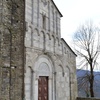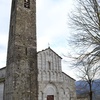San Cassiano di Controne
The church of San Cassiano, an important example of a Romanesque church, is one of the most beautiful ecclesiastical buildings within the rural area of Lucca. The square bell tower is the oldest structure still standing, dating back to the eleventh century.
The beautiful facade, supported against the existing bell tower, is decorated with alternating two-tone bands of white and grey limestone and overlapping arches, pronounced by three rows of blind arches and embellished with diamonds and orbs. A ceramic basin of Islamic production, which dates from the twelfth century and depicts a man riding a horse, is inserted at the highest point of the gable inside the walls.
The interior, with three naves divided by columns and pillars, preserves fragments of a pulpit from the thirteenth century, the carved capitals of the columns of the nave and a shrine from the fifteenth century. The floor is in "opus alexandrinum" - inlaid marble in geometric patterns - used in the building of churches in the twelfth century Lucca. The church's heritage includes the carved wooden statues of Sant'Ansano and Christ Crucified attributed to Francesco Valdambrino (XV cent.), the statue of San Martino on Horseback attributed to Jacopo della Quercia (XV cent.) and Madonna Annunciate with the Angel of the Annunciation by S. Cassiano (XIV cent.).
Historical notes
The church stands in the centre of the Controneria and, as in other towns of the Media Valle, over the centuries it represented a unifying hub around which the settlement developed. The first mentions of the church are very old, dating back to 772 and 913; the church also appears in the records of tithes from the years 1275, 1276 and 1387, from which we know that it received very considerable rents for a dependant church.
The term Controneria today indicates a vast area of rolling hills, along the bank of the Lima river, known since the Lombard age as "Fines Contronenses", one of the three administrative districts in which the mountain of Lucca was then divided. The term "fines" stood for the territorial districts that took their name from a castle, often associated with a church. In the case of the Controneria, the "castrum" in question could be identified in the traces of a fort discovered on the Colle di Castello overlooking Pieve di Controne.
Today the Controneria includes several towns, including San Cassiano di Controne, San Gimignano and Pieve di Controne.










